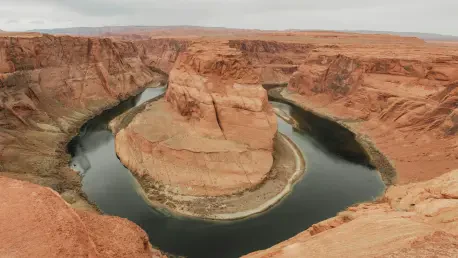What happens when a river that sustains over 40 million people across seven states begins to vanish under the weight of drought and discord? The Colorado River, a lifeline for the American West, is drying up, with reservoirs like Lake Mead at historic lows, threatening water supplies, power generation, and entire economies. As a critical mid-November deadline looms to establish new management rules, the states that rely on this vital resource are trapped in a deadlock, unable to agree on how to share what little remains. This is a story of survival, division, and the urgent race against time in a region parched by nature and politics alike.
The Stakes: Why This River Matters More Than Ever
The significance of the Colorado River cannot be overstated—it is the backbone of life for communities, agriculture, and industries from Colorado to California. With Lake Mead, a key reservoir, sitting at just 31% capacity and 1,054 feet above sea level, the crisis is no longer a distant threat but a present emergency. This decline not only jeopardizes drinking water for millions but also slashes hydropower output at Hoover Dam, which now generates half the energy it did two decades ago. With current management guidelines set to expire at the end of 2026, the impending deadline to forge a new plan is a make-or-break moment for the region’s future.
Beyond the numbers lies the human toll, as farmers, city dwellers, and tribal nations grapple with uncertainty over access to this shrinking resource. The river’s health dictates whether crops grow, lights stay on, and taps keep running in a part of the country where rainfall is a rare gift. If no agreement is reached by November, federal intervention looms, potentially imposing rules that could reshape the West’s water landscape in ways no state fully controls.
A History of Strain: The River’s Diminishing Flow
Decades of drought, intensified by climate change, have pushed the Colorado River to its limits, transforming it from a mighty current into a fragile thread. Reservoirs that once brimmed with water are now stark reminders of scarcity, with Lake Mead’s surface a staggering 175 feet below its full mark. This isn’t just a natural disaster; it’s a slow unraveling of a system built on outdated assumptions of endless abundance, assumptions that no longer hold in a warming, drying world.
The consequences ripple far beyond water itself, as hydropower at Hoover Dam—a critical energy source for the region—teeters on the edge of collapse. Experts warn that a further drop of just 20 feet to 1,035 feet could slash power generation by 70%, darkening homes and straining economies already under pressure. This escalating crisis sets the stage for the contentious negotiations among states, each fighting to protect its share of a resource that’s disappearing faster than solutions can emerge.
Divisions Run Deep: The State-by-State Standoff
At the heart of this emergency is a profound disagreement among the seven states that depend on the river, split between the Upper Basin (Colorado, New Mexico, Utah, Wyoming) and the Lower Basin (Nevada, Arizona, California). Historical tensions over water rights have flared into open conflict, with each side pointing fingers over who should bear the brunt of necessary cuts. Past attempts at dialogue, such as a meeting in Las Vegas last December, ended in stony silence, revealing just how wide the chasm has grown.
A glimmer of hope surfaced in July with a proposal to allocate water based on real-time river flows rather than old, overly optimistic projections. While this idea promises a fairer approach suited to today’s harsh realities, the devil remains in the details, and consensus is elusive. Without a breakthrough by mid-November, the federal government may step in, a prospect that unnerves all parties but seems increasingly inevitable given the entrenched divisions.
Voices of Urgency: Perspectives from the Edge
From the front lines of this battle, the frustration is palpable, yet so is the determination to find a way forward. Colby Pellegrino, Deputy General Manager of the Southern Nevada Water Authority, recently voiced cautious optimism about the real-time flow proposal, though admitted the gap to a final deal remains vast. Speaking at a recent water summit in Southern Nevada, hosted by Rep. Susie Lee, Pellegrino emphasized the need for compromise, warning that time is a luxury the region no longer has.
Other stakeholders echo this urgency, with experts at the summit highlighting the risk of federally imposed rules if states can’t unite. Nevada’s own story stands as both inspiration and caution—despite receiving less than 2% of the river’s water, it has slashed usage by 36% over recent years through aggressive conservation. Yet, as one policymaker noted, individual success means little if the broader region fails to act, painting a picture of isolated progress amid collective gridlock.
Nevada’s Blueprint: Conservation as a Lifeline
Amid the deadlock, Nevada emerges as a standout, offering lessons in resilience through innovation and sacrifice. With projects like the Intake 3 pipeline and the Low Lake Level Pumping Station, Southern Nevada has secured water access even under dire conditions, ensuring supply when Hoover Dam releases falter. Funding from the Southern Nevada Public Land Management Act, totaling over $368 million, has bolstered these efforts, supporting infrastructure and drought planning on a scale few states match.
Federal support has also played a role, with $4 billion from the Inflation Reduction Act allocated for drought mitigation across the West, alongside specific investments in Nevada’s water systems. These measures have temporarily stabilized Lake Mead through 2026 by cutting millions of acre-feet in usage, a model of efficiency that could guide others. Still, scaling such success basin-wide requires a level of cooperation that remains frustratingly out of reach, leaving Nevada’s achievements as a bright spot in a darkening landscape.
Charting the Path Ahead: Solutions in a Shrinking Window
Looking toward resolution, actionable strategies are on the table, though each comes with hurdles. Adopting the July framework of real-time flow allocations must be prioritized, demanding transparent data sharing and agreed-upon metrics to ensure fairness across states. Interim agreements before November could stave off federal overreach, focusing on proportional cuts based on usage while long-term projects, like Hoover Dam’s $8 million per turbine upgrades, preserve critical hydropower.
Legislative efforts, such as the Help Hoover Dam Act aiming to unlock $50 million for dam improvements, signal political will to address infrastructure needs, though the full $200 million required looms large. States must also lean on federal drought funding to replicate conservation models like Nevada’s, investing in efficiency while rebuilding trust across basins. These steps, though fraught with complexity, offer a roadmap to avert collapse, provided the will to act materializes before the deadline slips away.
Reflecting on a Parched Struggle
As the mid-November deadline passed without resolution, the Colorado River states found themselves mired in a standoff that history would judge harshly. The river, once a boundless provider, had become a symbol of scarcity and strife, its dwindling flows mirroring the fractured alliances of those who depended on it. Yet, amidst the discord, glimmers of innovation and resolve—seen in Nevada’s conservation triumphs and proposed adaptive policies—offered a faint hope that had yet to be fully grasped.
Moving forward, the path demanded unprecedented collaboration, with states urged to finalize real-time allocation plans and secure federal support for infrastructure like Hoover Dam before further decline struck. Investments in long-term sustainability, paired with shared sacrifice, stood as the only way to ensure the river’s legacy endured. The West had faced a critical test, and though the outcome remained uncertain, the call to unite and innovate echoed as a mandate for survival in a region forever changed by drought.









